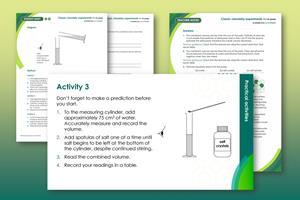Use common classroom items to explore physical states and how materials interact
-

Download this
Everything you need to run this practical lesson with classroom slides, scaffolded and unscaffolded student worksheets and teacher guidance, including full technical notes and answers to all questions.
View and download more Classic chemistry experiments
When materials are added together, they may acquire new properties. When a solid and a liquid are mixed, the solid may or may not dissolve. When two liquids are mixed they may become one liquid or stay separate. These experiments provide an opportunity for learners to predict and then observe what happens.
Learners measure any changes in volume when solids are mixed with solids, alcohol is mixed with water and salt is dissolved in water.
Learning objectives
- Predict how the volume will change when two substances are mixed together.
- Make careful observations.
- Apply your knowledge of particles to explain your observations.
Before starting the practical, learners should make and note down on their worksheet a prediction for each practical activity (learning objective 1). Encourage them to state a reason for their prediction. You may need to remind learners what is meant by the term prediction and have a general discussion about what could happen when substances are mixed before they make their predictions.
Learners should carry out the practical activities in groups of two or three and record their observations on the student sheet (learning objective 2).
By working through the questions on the worksheet, learners will suggest explanations for their observations (learning objective 3).
Scaffolding
There are two versions of the student worksheet: scaffolded (✪) and unscaffolded (✪✪). The scaffolded sheet offers more support such as pre-drawn results tables and more structured answers to the questions.
Some groups of learners may need reminding not to try and measure 25 cm3 accurately straight away. It is better to pour approximately, then take an accurate measurement.
For those learners working at a fast pace, a suitable extension activity would be to plan (and carry out) an experiment to show that conservation of mass occurs when these substances are mixed.
Technician notes
Read our standard health and safety guidance and carry out a risk assessment before running any live practical.
Apparatus
Per learner:
- Eye protection: safety glasses to EN166F
Per group:
- Stirring rod
- Measuring cylinders x 2 (100cm3)
- Spatula
Chemicals (per group)
- Sodium chloride cyrstals (~40 g)
- Water (~100 cm3)
- Sand (~25 cm3)
- Dried peas (~25 cm3)
- Ethanol (~25 cm3) (DANGER: highly flammable liquid and vapour)
Health, safety and technical notes
- Read our standard health and safety guidance.
- Always wear eye protection.
- Ethanol is flammable, ensure no naked flames or other sources of ignition (see CLEAPSS Hazcard HC040a/SSERC)
Procedure
Activity 1
- Add approximately 25 cm3 of dried peas and 25 cm3 of sand to separate measuring cylinders. Accurately measure and record the volumes.
- Add contents of one cylinder to the other and shake until the two substances are mixed together.
- Place the measuring cylinder on the bench and gently shake from side to side to allow the mixture to settle.
- Read and record the combined volume.
Activity 2
- Add approximately 25 cm3 of ethanol and 25 cm3 of water to separate measuring cylinders. Accurately measure and record the volumes.
- Add the contents of one cylinder to the other and shake from side to side for 15–30 seconds until the two substances are mixed together, and then leave to stand for 1 minute.
- Read and record the combined volume.
Activity 3
- To the measuring cylinder, add approximately 75 cm3 of water. Accurately measure and record the volume.
- Add spatulas of salt one at a time until salt begins to be left at the bottom of the cylinder, despite continued stirring.
- Read and record the combined volume.
Teaching notes
The learner predictions and their suggestions will provide an insight into their understanding of particles and how they mix.
In each activity, the combined volume will be less than the total of the two individual volumes.
Suggested reasons may include:
- The idea that different particles have different sizes and so the smaller one might fit in between the larger ones.
- The idea that water and alcohol are continuous materials, with the heavier one resting on the other – therefore squashing the lighter one.
In questions 1 and 2, learners should be encouraged to suggest explanations for their results, even if the inferences seem not to support their predictions – e.g. 25 cm3 peas + 25 cm3 sand = 46 cm3 total volume.
Downloads
Experiments with particles student sheet scaffolded
Handout | PDF, Size 0.19 mbExperiments with particles student sheet unscaffolded
Handout | PDF, Size 0.19 mbExperiments with particles presentation
Handout | PDF, Size 0.49 mbExperiments with particles teacher notes teacher notes
Handout | PDF, Size 0.25 mbExperiments with particles student sheet scaffolded
Editable handout | Word, Size 0.61 mbExperiments with particles student sheet unscaffolded
Editable handout | Word, Size 0.61 mbExperiments with particles presentation
Presentation | PowerPoint, Size 1.46 mbExperiments with particles teacher notes teacher notes
Editable handout | Word, Size 0.62 mb
Additional information
This practical is part of our Classic chemistry experiments collection. The supporting resources were updated in 2025 by Dorothy Warren.






















No comments yet